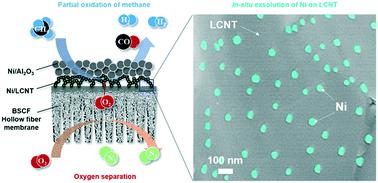当前位置:
X-MOL 学术
›
React. Chem. Eng.
›
论文详情
Our official English website, www.x-mol.net, welcomes your
feedback! (Note: you will need to create a separate account there.)
Tailoring of a catalyst La0.8Ce0.1Ni0.4Ti0.6O3−δ interlayer via in situ exsolution for a catalytic membrane reactor
Reaction Chemistry & Engineering ( IF 3.4 ) Pub Date : 2021-4-17 , DOI: 10.1039/d1re00103e Ping Luo 1, 2, 3, 4, 5 , Zhi Xu 1, 2, 3, 4, 5 , Qiankun Zheng 1, 2, 3, 4, 5 , Jinkun Tan 1, 2, 3, 4, 5 , Zhicheng Zhang 1, 2, 3, 4, 5 , Zhengkun Liu 1, 2, 3, 4, 5 , Guangru Zhang 1, 2, 3, 4, 5 , Wanqin Jin 1, 2, 3, 4, 5
Reaction Chemistry & Engineering ( IF 3.4 ) Pub Date : 2021-4-17 , DOI: 10.1039/d1re00103e Ping Luo 1, 2, 3, 4, 5 , Zhi Xu 1, 2, 3, 4, 5 , Qiankun Zheng 1, 2, 3, 4, 5 , Jinkun Tan 1, 2, 3, 4, 5 , Zhicheng Zhang 1, 2, 3, 4, 5 , Zhengkun Liu 1, 2, 3, 4, 5 , Guangru Zhang 1, 2, 3, 4, 5 , Wanqin Jin 1, 2, 3, 4, 5
Affiliation

|
The application of catalytic membrane reactors (CMRs) based on a perovskite-type oxygen-permeable membrane has been greatly limited by the instability of a membrane material. In this study, A-site deficient perovskite La0.8Ce0.1Ni0.4Ti0.6O3−δ (LCNT) as a modification porous interlayer (between a Ni/Al2O3 catalyst and membrane) was applied on a Ba0.5Sr0.5Co0.8Fe0.2O3−δ (BSCF) four-channel hollow fiber membrane to construct a CMR. Ni nanoparticles were in situ exsolved from the LCNT surfaces and used for partial oxidation of methane (POM). The porous LCNT layer shows excellent attachment, effective protection and enhanced catalytic activity to the BSCF four-channel hollow fiber membrane. The LCNT/BSCF CMR shows a more than 700 h stability in POM which is much higher than that without the modification of the LCNT porous layer (which is less than 150 h). At 900 °C, more than 99% CH4 conversion and CO selectivity have been achieved in the LCNT/BSCF CMR. Our results have demonstrated the feasibility of coupling an in situ exsolution Ni nano-catalyst porous layer with the perovskite-type membrane, providing a new strategy for enhancing both the stability and catalytic activity of CMRs.
中文翻译:

通过原位解膜为催化剂膜反应器定制La0.8Ce0.1Ni0.4Ti0.6O3-δ中间层催化剂
基于钙钛矿型透氧膜的催化膜反应器(CMR)的应用受到膜材料的不稳定性的极大限制。在这项研究中,在Ba 0.5 Sr 0.5上施加了A位缺陷型钙钛矿La 0.8 Ce 0.1 Ni 0.4 Ti 0.6 O 3- δ(LCNT)作为改性多孔中间层(Ni / Al 2 O 3催化剂和膜之间)。用Co 0.8 Fe 0.2 O 3− δ(BSCF)四通道中空纤维膜构建CMR。镍纳米粒子原位从LCNT表面溶解并用于甲烷(POM)的部分氧化。多孔LCNT层对BSCF四通道中空纤维膜表现出出色的附着力,有效的保护作用和增强的催化活性。LCNT / BSCF CMR在POM中显示超过700小时的稳定性,这比未经修饰的LCNT多孔层(少于150小时)要高得多。在900°C下,LCNT / BSCF CMR的CH 4转化率和CO选择性均超过99%。我们的结果证明了将原位析出Ni纳米催化剂多孔层与钙钛矿型膜耦合的可行性,为增强CMR的稳定性和催化活性提供了新的策略。
更新日期:2021-05-06
中文翻译:

通过原位解膜为催化剂膜反应器定制La0.8Ce0.1Ni0.4Ti0.6O3-δ中间层催化剂
基于钙钛矿型透氧膜的催化膜反应器(CMR)的应用受到膜材料的不稳定性的极大限制。在这项研究中,在Ba 0.5 Sr 0.5上施加了A位缺陷型钙钛矿La 0.8 Ce 0.1 Ni 0.4 Ti 0.6 O 3- δ(LCNT)作为改性多孔中间层(Ni / Al 2 O 3催化剂和膜之间)。用Co 0.8 Fe 0.2 O 3− δ(BSCF)四通道中空纤维膜构建CMR。镍纳米粒子原位从LCNT表面溶解并用于甲烷(POM)的部分氧化。多孔LCNT层对BSCF四通道中空纤维膜表现出出色的附着力,有效的保护作用和增强的催化活性。LCNT / BSCF CMR在POM中显示超过700小时的稳定性,这比未经修饰的LCNT多孔层(少于150小时)要高得多。在900°C下,LCNT / BSCF CMR的CH 4转化率和CO选择性均超过99%。我们的结果证明了将原位析出Ni纳米催化剂多孔层与钙钛矿型膜耦合的可行性,为增强CMR的稳定性和催化活性提供了新的策略。











































 京公网安备 11010802027423号
京公网安备 11010802027423号